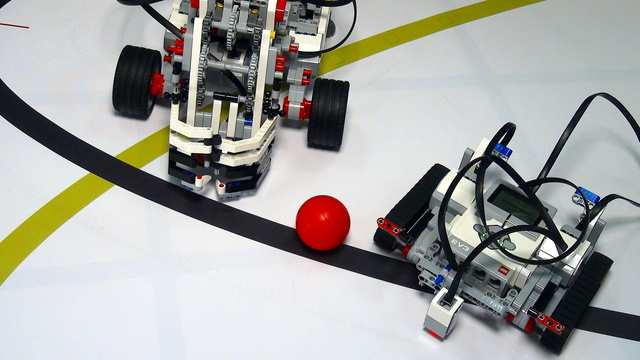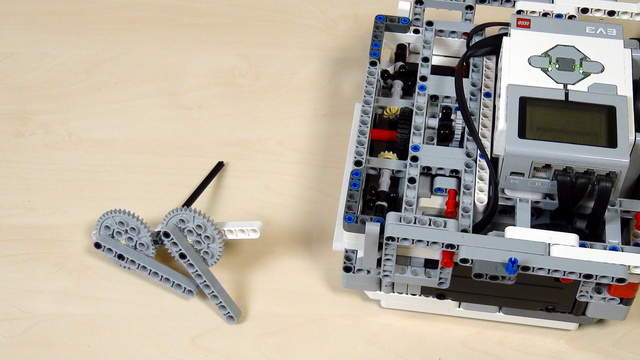
Collecting object program
- #obrakw
- 27 Mar 2016



Time to lift the robot. The first approach is by using the 40 teeth gear wheels that come with the LEGO Mindstorms EV3 and NXT robotics sets.


How to align the wheels and how much should you push for this solution?


Here is our solution for preventing torsion and bending of the LEGO Mindstorms EV3 axles.

If you take a look at the videos for this attachment you will see a nice idea on taking the track and the ambulance. These two vehicles from the FIRST LEGO League 2013 competition had to be collected and returned back to base.
Built from LEGO Mindstorms EV3 parts.

This is version 2 of the LEGO Mindstorms Grabber. It makes use of 4 gears to make both levers active.

This construction demonstrates one way of using а rack with a gear wheel. It allows to turn circular motion in to a liniar one.

Here is an example of Four(4) active LEGO Mindstorms attachments built-in the frame. Two by two they work asynchronously since all of them are connected to the two separate middle motors of the SUV robot via the frame.
The left attachments work synchronously, and the right attachments are also synchronized couple.
These specific attachments are meant to do nothing in particular, but to serve as an example. Their purpose is to demonstrate different ways in which one could add an attachments to the frame. Experiment. Think and invent better frame with real world attachments that could actually do efficient work and accomplish a mission. Take a video then and share it with us.

Forth version of a reusable gear attachment. Again, it powers two axles and this time there is a lever connected to one of the axles.

This reusable attachment could easily be placed on the side of a LEGO MINDSTORMS Robot Inventor robot and accomplish different missions that require the robot to interact with mission models. It uses gear wheels.


This tutorial explains the use of motion and light/color sensors to accomplish a complex mission split into three parts. It gets into detail about how we keep a straight line with the motion sensor, follow a line with the color sensors, and transition between different parts of the program by aligning and detecting lines with the sensor. The goal is to get to a reliable and consistent behavior of the robot. On top of that, it is configurable, as we've left a few parameters that could be set to configure the behavior for a specific robot, venue, lighting, battery level, and wheels friction.

These are 3D building instructions for an active pinless attachment from LEGO Education SPIKE Prime set. The attachment is used along with the Gazon robot to push mission models.

We experimented with building a box robot powered entirely by chains—a unique approach inspired by the original LEGO MINDSTORMS NXT Robots. Chains like these can be hard to find, but we thought: why not try to power both the robot and its attachments with them? This design not only powers the entire robot but also provides a great demonstration of how and when chains can be effectively used in robotics.
To build this robot, you'll need approximately 180 chain links (part 3711a), which are available in the NXT kits and some Technic sets.
Please note that this robot requires additional components beyond those included in the LEGO Education SPIKE Prime and SPIKE Essential kits. Check out the additional parts required.


Energy storage mission from FIRST LEGO League 2022-2023 is again a two parts mission where we have to drop a few energy units in the mission model, but we also have to pull part of the mission model. In this video tutorial we demonstrate how the Chain Monster LEGO box robot accomplishes this with a multi purpose attachment for box robots.

This attachment is accomplishing three missions and partly two more missions from the FIRST LEGO League 2022-2023. It is for the Chain Monster robot


This FRIST LEGO League video tutorial is about he Boccia Share mission from FIRST LEGO League 2020 RePlay competition. In the tutorial we demonstrate how to push on a lever to release a mission model part - in this case a box. You have the choice before the competition to cooperate with the other team and to decide if you are going to do the blue or the red box.


In this video tutorial, the Chain Monster box robot accomplishes three missions in a single run from the FIRST LEGO League 2023-2024 MASTERPIECE Challenge season. The LEGO Education SPIKE Prime robot uses an active attachment to collect the mini figures, to push a lever, and to deliver the figures to their designated places. The robot starts from the red base and returns to the blue base, performing all these actions in less than 20 seconds - consistently and reliably.


This is a 10 out of 10 tutorial in which the MiniBox robot accomplishes the M12, M13, and M15 of the FIRST LEGO League 2023-2024 MASTERPIECE Challenge competition. The MiniBox is a LEGO Education SPIKE Prime box robot that uses detachable attachments.
In this run, the robot performs five actions: it collects the M15 minifigure and throws it backward, rotates the chicken for M12, and then pushes and pulls the M13 Craft Creator mission model. All of these actions are completed in under 15 seconds!

In this course, we demonstrate and explain example solutions for the FIRST LEGO League 2023-2024 MASTERPIECE competition using the Chain Monster box robot as a base, with custom-built attachments. Each solution is powered by a Python program that controls the robot to accomplish various missions efficiently. Every year, we share our solutions and insights only after the season is over.
The course is unique in its focus on multiple missions in a single run, showcasing runs that complete 3, 4, and even 5 missions in succession. We not only analyze these runs but also dive into the details of each individual mission, explaining the programming logic behind them. By following this course, you’ll gain a deeper understanding of how Python is used to automate mission execution and optimize your team's performance in FLL competitions.
Before starting this course, we recommend reviewing the FIRST LEGO League robot game guide.